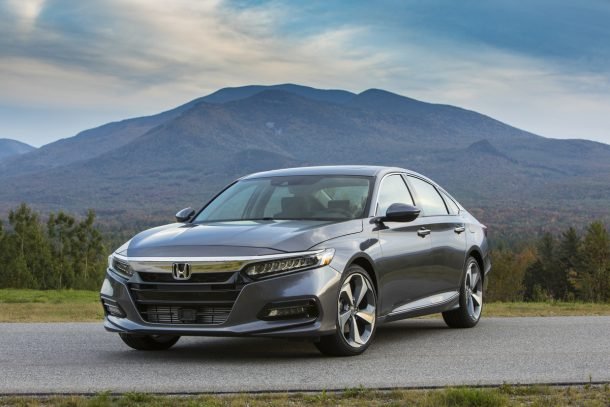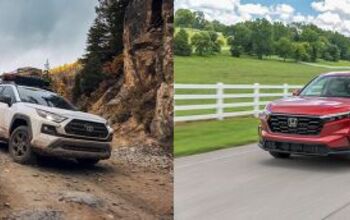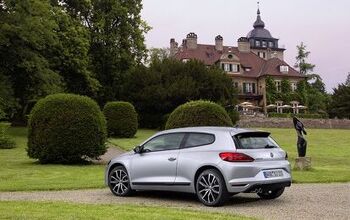No Fixed Abode: LaneWatch, We Hardly Knew Ye

I don’t know who coined the term — I suspect it was Car and Driver, which was then at an all-time peak of editorial excellence — but this is probably one of those cases where success has many fathers, and the child in this case was the phrase “idiot light.”
Let’s say that you were a new-car buyer in 1977. The vast majority of the cars you saw in a dealership would have just two gauges: speedometer and fuel level. Any other information was conveyed in binary fashion by a set of light-up warnings. The typical Seventies American car would have TEMP (for overheating), OIL (for lack of oil pressure), ALT (alternator/battery), and BRAKE (for low brake fluid), but some models had additional lights for low coolant and other functions.
The self-appointed automotive cognoscenti were very contemptuous of these lights, because they didn’t convey much information and they usually didn’t convey it until things had gotten drastic. Why not have a temperature gauge to let you know that your car was getting hot on the way up the Grapevine? Or an oil-pressure gauge, to give you a general idea of your engine health? Why couldn’t the driver be trusted to know the real information and to act accordingly?
Eventually, the “buff books” got their way and most cars started arriving in showrooms with at least a tachometer and a temp gauge in addition to speedo and fuel. The presence of extra gauges became the in-dash equivalent of a decklid spoiler, with various sporting models adding information on oil pressure, oil temperature, and boost pressure — where applicable, of course. This was done to make the driver feel like he was behind the wheel of a race car. Never mind the fact that modern race cars have embraced the “idiot light” wholeheartedly. My wife’s MX-5 Cup car has no fewer than six programmable warning lights flanking the tach. When you’re racing for real, it’s better to have a very bright light pop on every time there’s a real problem. It saves you the trouble of replacing the engine.
Today’s cars offer an absolute surfeit of available information through programmable dashboard layouts, of course, but the battle still rages between people who want to see analog information — let’s call them Evaluators — and people who just want to see a light — let’s call them Booleans. You can tell a lot about a car company, and that car company’s intended customer base, by seeing whether they cater to Evaluators or Booleans on any given subject. Consider, if you will, the 2018 Accord, which abandons the former and jumps to the latter in one significant aspect.
Honda’s LaneWatch appeared five years ago and, from the moment I saw it, I knew the whole industry would have to copy it or die trying. It works very simply: when you put your right turn signal on, it shows you a view of your right-side “blind spot” with helpful markings to show where the back bumper of your car would be if you moved over there. The display is remarkably clear and entirely accurate; if you can see a sliver of space between a bumper and the red line, your car is going to fit, no questions asked. In most of the cars to which it was fitted, including my 2014 Accord Coupe, the LaneWatch display is relatively high and central on the dashboard, so you don’t have to take your eyes completely off the road ahead in order to see what’s behind you and to the right. It can also be manually activated if you just want to take a look over there for motorcycles, cyclists, or low-roofed sports cars.
LaneWatch is utterly brilliant — if you have an idea of how to use it. It gives you all the information you need to determine if you should move into the next lane and when you should make that move. It’s a godsend in cramped rush-hour traffic, where it lets you sneak into tiny spots on your way over to an off-ramp. It’s brilliant in states that permit lane-splitting; you can take a peek to see if there’s a motorcycle over there. In urban traffic, you can leave it switched on in order to keep an eye out for cyclists.
I wasn’t the only person to sing the praises of LaneWatch, although Jamie LaReau at Automotive News disliked it because it kept you from being able to change radio stations while you were changing lanes. Most of my autojourno friends and foes agree that it’s a solid feature. It even makes you a slightly better citizen of the road, because it only activates by default when you use your right turn signal. I figured that pretty much every automaker out there would eventually figure out a way to put something similar in their cars, particularly since a lot of entry-luxury sedans and SUVs already have a “birdview” camera arrangement for parking.
Turns out I was wrong. LaneWatch didn’t catch on anywhere else. Worse yet, it’s now disappearing from Honda products, starting with the 2018 Accord. That fine vehicle has dispensed with LaneWatch in favor of an utterly conventional blind-spot monitoring system just like the ones found everywhere from Audi to Kia. In other words, they paved paradise and put up a parking lot. Or maybe you can say that they wiped out analog information and put up an idiot light.
I don’t trust the idiot light. The engineer in me doesn’t like the failure mode. You see, when LaneWatch fails you get a black screen, which lets you know that you’d better crane your neck old-fashioned style. But when BLIS fails, you just get a mirror devoid of warnings. LaneWatch is like a John Updike novel, full of trenchant observations and little details. BLIS is like the sullen teenager who comes from school and responds to all queries with a mumbled “Fine.” With LaneWatch, you can slip into the tightest spots; with BLIS, you guess and crank. LaneWatch will show you a car that is approaching at an unusual and/or unreasonable closing speed; BLIS stays silent until the car hits the radar beam. I know which one I prefer. Hell, if I had my way you’d have LaneWatch on both sides, depending on which way you flicked the turn-signal lever.
If I had to guess, I’d say that LaneWatch disappeared for two reasons. The first reason: it’s probably cheaper to do BLIS now. The sensors and mirrors are all standard Tier 1 supplier commodity grade now. The second reason is a little more frustrating. I suspect that Honda dealers didn’t like educating their customers on LaneWatch. If you’ve read Arrogance and Accords, you know how and why Honda dealers came to be pretty much the worst in the business, with the possible exception of Toyota shops. They like to rake in the money with the absolute minimum of effort. Showing customers how to get the most out of an analog feature like LaneWatch isn’t part of that program. Au revoir, then.
It might not be the end. At some point, someone will figure out how to build a wireless heads-up LaneWatch-style system that works with everything from Civics to Silverados. You’ll have to calibrate the red lines yourself, but that could be done in ten minutes with the help of a friend. I’d probably buy a system like that for my race cars, because having extra eyes on both sides of the car can be the difference between winning and losing. Until then, however, it’s back to the idiot lights. Maybe that’s all we deserve. A nation of idiots, too busy to be watchful.
[Images: Honda]

More by Jack Baruth
Latest Car Reviews
Read moreLatest Product Reviews
Read moreRecent Comments
- Calrson Fan We are already seeing multiple manufacturers steering away from EVs to Hybrids & PHEVs. Suspect the market will follow. Battery tech isn't anywhere close to where it needs to be for EV's to replace ICE's. Neither is the electrical grid or charging infrastructure. PHEV's still have the drawback that if you can't charge at home your not a potential customer. I've heard stories of people with Volts that never charge them but that's a unique kind of stupidity. If you can't or don't want to charge your PHEV then just get a hybrid.
- AZFelix The last time I missed the Malibu was when one swerved into my lane and I had to brake hard to avoid a collision. 1 out of 5⭐️. Do not recommend.
- 2ACL I won't miss it; it was decent at launch, but in addition to the bad packaging, GM did little to keep it relevant in the segment. I'd prefer that another domestic automaker doesn't just give up on the mainstream sedan, but unlike some of Ford's swan songs, the Malibu made an indifferent case for why they should live.
- ToolGuy TG grows weary of purchasing gasoline. I don't care so much how or why, I am just tired of it. I still buy petroleum products, not 'boycotting oil,' but backing away from gasoline where I can. Sample size = 1.
- Probert Maybe it's not too late for the Dodge Neon I've always dreamed of!!! To the keyboard Robin!



































Comments
Join the conversation
I'm surprised this is such a popular feature among those who have it. I recall derision in car reviews when it was released, and I figured it would be something I'd dislike; I despise any sort of unnecessary animation in my peripheral vision when I'm trying to focus. But maybe they just needed more time with it and it actually is a useful tool once you've adapted your lane changing routine to accommodate it. Once it's familiar enough to no longer be a distraction, I could see how a glance at the screen while looking over to the side mirror or after might give a person a little more detail and confidence about what's happening beside him. I drove a Chevette for a couple of years as a teenager, and it had no passenger side mirror. Overall visibility in that car was excellent though, so I simply got used to turning my head a little further and seeing first-hand whether there were any vehicles beside me. I stay fully aware of all traffic around me with frequent glances at the available mirrors, so I was never surprised by a fast-moving vehicle on the right and it didn't even seem like a possibility that I could miss one. Not too many drivers were ever going faster than me at that time anyway. I concluded that passenger side mirrors were just a source of unnecessary weight and aerodynamic drag. After that, I actually had to re-train myself to glance at the passenger side mirror at the start of a shoulder check during a lane change. For me, it's really just a final check on the way to my shoulder check, to ensure that a vehicle isn't speeding up on that side. I never eliminated the habit of looking far enough back to see anything even close to the back of my car on the right. I'm just more comfortable confirming the open space that way, and I tend to be much more conservative about lane changes in vehicles where I truly need the mirror for a full view. Despite that now-unnecessary degree of head movement, I do appreciate having the passenger side view mirror as well. So I suppose even my luddite self can understand how Lane Watch might be useful as an additional confirmation. But it's not something I'd pay extra for. I would, however, pay extra for, or simply choose, a vehicle with good outward visibility.
I'm considering buying a new HR-V. I've had lanewatch since 2015 and i don't want to give it up. Do I need to get the 2018 HR-V or will it still be available on the 2019's? I saw the the new Honda Insight for 2019 with have the lanewatch. Is there hope that they've had so many complaints that it's staying?